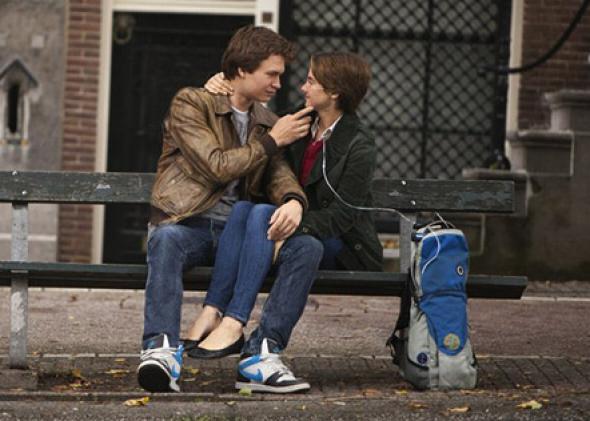It’s not an enjoyable feeling, sitting down to write a negative review of the movie about dying teenagers in love. The movie based on a beloved and critically praised YA best-seller by John Green, starring the enthralling young actress (and doe-like beauty) Shailene Woodley. The movie in which a bright, curious 16-year-old girl with metastatic thyroid cancer finds romance with an 18-year-old fellow survivor who’s lost a leg to the disease. To remain, for the most part, unmoved by Josh Boone’s heartfelt adaptation of The Fault In Our Stars raises as many questions about one’s character as about one’s critical acumen. What in the name of God is wrong with me that I didn’t cry once—I, who just the day before wept through the entirety of my child’s thoroughly upbeat school play.
From the moment Woodley’s character, Hazel Grace Lancaster, identifies herself in an opening voice-over as “the Keith Richards of cancer kids,” The Fault in Our Stars is eager to display that it isn’t one of those cancer movies, not part of the tradition of the soapy “sick flick” in which beautiful young people—usually women—die far too soon, but nobly and photogenically, their distraught lovers by their sides. I don’t doubt that, for many viewers, The Fault in Our Stars will succeed in subverting that model—it certainly allows its heroine more agency, and better wisecracks, than your run-of-the-mill Nicholas Sparks tearjerker. But for all the film’s best intentions—and a finely tuned performance from the ever-better Woodley—for me The Fault in Our Stars never entirely found its way out of Sparks territory.
Maybe it’s simply that the pairing at the film’s center, between Woodley’s Hazel and Ansel Elgort’s Augustus Waters, never catches fire the way Woodley and Miles Teller’s relationship did in last year’s exceptional high-school romance The Spectacular Now (written by Fault’s screenwriters Scott Neustadter and Michael H. Weber). Elgort, a tall, loose-limbed, handsome kid with a permanent bemused smirk, is no match for Woodley’s fluid expressive range (as we saw earlier this spring when they played brother and sister in another YA adaptation, Divergent). You believe Gus would fall for Hazel, but you have to take it on faith that his charms—which struck this viewer as slightly synthetic and stiff—would work on her.
Hazel is the only child of two loving, anxious parents (Laura Dern and Sam Trammell), who insist she attend a cancer-support youth group in the basement of a church (led by a sanctimonious Christian played by Mike Birbiglia). On her first night there, she bumps (literally) into the eccentric Augustus (Elgort), a former basketball star who, since losing a leg to cancer, has taken to going around with an unlit cigarette in his mouth, by way of letting the disease know who’s boss. Gus is immediately charmed by this self-possessed, unsentimental young woman, breathing tube and all. But Hazel is wary to let herself fall for someone when she doesn’t know how long she has left.
Once Hazel finally starts warming to the insistent Gus, one of her first gestures of courtship is to persuade him to read her favorite book, An Imperial Affliction—the account of a young girl’s struggle with illness that ends, hauntingly, in the middle of a sentence. Gus cashes in his wish at a Make-A-Wish-style foundation to offer Hazel a trip to Amsterdam, where the book’s author, Peter van Houten (Willem Dafoe), lives as a recluse. The impossible-to-embarrass Gus arranges for a meeting between Hazel and her literary hero. But instead of engaging with his delightful young fan’s questions, a drunk van Houten insults her with astonishing cruelty: “You’re a failed experiment in mutation.” Even after this disillusioning visit, Hazel and Gus manage to spend a romantic three days in Amsterdam, strolling over the canals (she with her rolling oxygen tank in tow), dining by candlelight, and at one point making out in the inner sanctum of the Anne Frank House—a breach of decorum that’s, mysteriously, applauded by their fellow museumgoers, none of whom seems to prioritize paying tribute to Holocaust victims over watching cute teenagers suck face.
There are moments in The Fault in Our Stars that transcend formula and cut straight to the heart. My eyes did start to sting in some scenes between Woodley and Dern, whose similar live-wire energy and lanky frames make them a convincing mother-daughter pair. Is there any way to watch Laura Dern’s incredible face crumple in grief without feeling yours crumple a little in sympathy? But in the film’s latter half—which, not to give anything away, goes to places even sadder than the already-bleak setup would suggest—Elgort really begins to bump up against his limits as an actor, even as Woodley shines brighter by contrast. The soundtrack also grows more intrusive as the movie goes along, laying so much schmaltzy pop under every scene that the music starts to crowd out the viewer’s ability to figure out for herself how she feels about all these tragic developments. Maybe it was that sense of emotional suffocation that lay behind my curious resistance to The Fault in Our Stars, a perfectly well-crafted and well-intentioned tearjerker that failed to wring a single drop from these usually vulnerable ducts.
